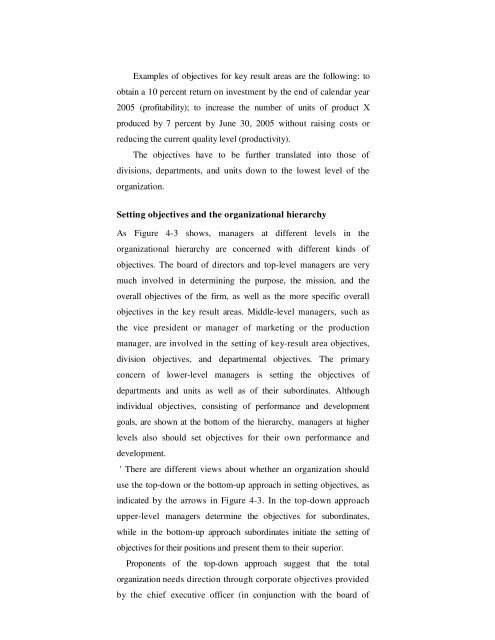Essentials of Planning and Managing by Objectives
Essentials of Planning and Managing by Objectives
Essentials of Planning and Managing by Objectives
Create successful ePaper yourself
Turn your PDF publications into a flip-book with our unique Google optimized e-Paper software.
Examples <strong>of</strong> objectives for key result areas are the following: toobtain a 10 percent return on investment <strong>by</strong> the end <strong>of</strong> calendar year2005 (pr<strong>of</strong>itability); to increase the number <strong>of</strong> units <strong>of</strong> product Xproduced <strong>by</strong> 7 percent <strong>by</strong> June 30, 2005 without raising costs orreducing the current quality level (productivity).The objectives have to be further translated into those <strong>of</strong>divisions, departments, <strong>and</strong> units down to the lowest level <strong>of</strong> theorganization.Setting objectives <strong>and</strong> the organizational hierarchyAs Figure 4-3 shows, managers at different levels in theorganizational hierarchy are concerned with different kinds <strong>of</strong>objectives. The board <strong>of</strong> directors <strong>and</strong> top-level managers are verymuch involved in determining the purpose, the mission, <strong>and</strong> theoverall objectives <strong>of</strong> the firm, as well as the more specific overallobjectives in the key result areas. Middle-level managers, such asthe vice president or manager <strong>of</strong> marketing or the productionmanager, are involved in the setting <strong>of</strong> key-result area objectives,division objectives, <strong>and</strong> departmental objectives. The primaryconcern <strong>of</strong> lower-level managers is setting the objectives <strong>of</strong>departments <strong>and</strong> units as well as <strong>of</strong> their subordinates. Althoughindividual objectives, consisting <strong>of</strong> performance <strong>and</strong> developmentgoals, are shown at the bottom <strong>of</strong> the hierarchy, managers at higherlevels also should set objectives for their own performance <strong>and</strong>development.' There are different views about whether an organization shoulduse the top-down or the bottom-up approach in setting objectives, asindicated <strong>by</strong> the arrows in Figure 4-3. In the top-down approachupper-level managers determine the objectives for subordinates,while in the bottom-up approach subordinates initiate the setting <strong>of</strong>objectives for their positions <strong>and</strong> present them to their superior.Proponents <strong>of</strong> the top-down approach suggest that the totalorganization needs direction through corporate objectives provided<strong>by</strong> the chief executive <strong>of</strong>ficer (in conjunction with the board <strong>of</strong>
















